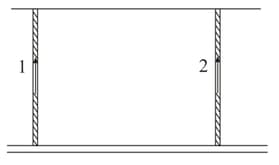A wave is given by the equation, . Find the loop length, frequency, velocity and maximum amplitude of the stationary wave produced.

Important Questions on Superposition and Standing Waves

Find the fundamental frequency and the first four overtones of a pipe, if the pipe is closed at one end, if the speed of sound,
Find the fundamental frequency and the first four overtones of a pipe, if the pipe is open at both ends.
Find the fundamental frequency and the first four overtones of a pipe. How many overtones may be heard by a person of normal hearing in each of the above cases? The velocity of sound in air .
A tube closed at one end has a vibrating diaphragm at the other end, which may be assumed to be a displacement node. It is found that when the frequency of the diaphragm is a stationary wave pattern is set up in which the distance between adjacent nodes is When the frequency is gradually reduced, the stationary wave pattern disappears, but another stationary wave pattern reappears at a frequency of Calculate the speed of sound in air,
